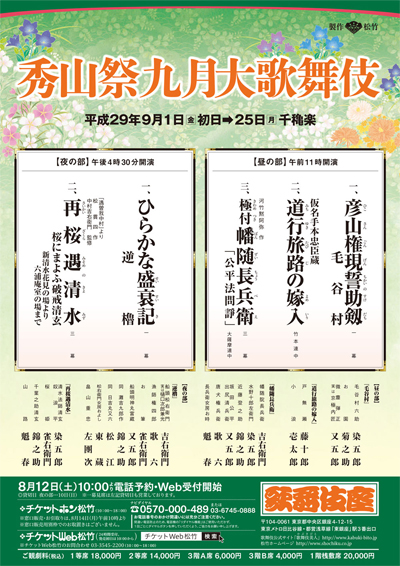| SEPTEMBER 2017 |
|
3 shows in T˘ky˘ (Kabukiza, Cerulean Tower N˘ Theater), 1 in Fukuoka (Hakataza), 2 in Ky˘to (ROHM Theatre, ROHM Theatre), 1 in Nagoya (Nagoya N˘ Gakud˘) and 1 tour (Western Provinces)!
|
| Kabukiza (T˘ky˘) |  |
| Dates | 1 ~ 25 September 2017 (Shűzan Matsuri Kugatsu ďkabuki) Shűzan's Festival September Grand Kabuki |
| MatinÚe |
Hikosan Gongen Chikai no Sukedachi (Keya-mura) |
| Evening |
Saikai Zakura Misome no Kiyomizu |
| Casting |
Living National Treasure Sakata T˘jűr˘, Living National Treasure Nakamura Kichiemon, Living National Treasure Nakamura T˘z˘, Nakamura Jakuemon, Nakamura Kaishun, Onoe Kikunosuke, Ichikawa Somegor˘, Nakamura Kinnosuke, Nakamura Kazutar˘, Nakamura Karoku, Nakamura Matagor˘, Kamimura Kichiya, Matsumoto Kingo, Nakamura Kikaku, Nakamura Matsue, Sawamura S˘nosuke, Arashi Kitsusabur˘, ďtani Keiz˘, Nakamura Kotar˘, Nakamura Kash˘, Nakamura Tanenosuke, Nakamura Yonekichi, Nakamura Hayato, Nakamura Kichinoj˘ |
| Comments |
The 10th edition in T˘ky˘ of a special program called "Shűzan Matsuri" (the festival of Shűzan) is staged at the Kabukiza to commemorate the great actor Nakamura Kichiemon I, whose's haimy˘ was Shűzan.
|
 |
| Kabuki Tour in the western provinces | |
| Dates | 31 August ~ 25 September 2017 |
| Program | |
| Casting |
Nakamura Shikan, Nakamura Baigyoku, Nakamura Senjaku, Onoe Sh˘roku, Band˘ Yajűr˘, Ichikawa Komaz˘, Nakamura Hashinosuke, Nakamura Fukunosuke, Nakamura Baika, Ichimura Kitsutar˘ |
| Comments |
The usual September Grand Kabuki Tour in the western provinces. Nakamura Shikan VIII and two of his three sons, Nakamura Hashinosuke IV and Nakamura Fukunosuke III, celebrate their shűmei.
|
|
|||
| Dates | 2 ~ 18 September 2017 (Band˘ Tamasabur˘ x Kod˘ Tokubetsu Buy˘ K˘en) Band˘ Tamasabur˘ x Kod˘ Special Dance Performances |
||
| Program |
Yűgen |
||
| Casting |
Living National Treasure Band˘ Tamasabur˘ |
||
| Comments |
Living National Treasure Band˘ Tamasabur˘ performs in Nagoya at the Aichi Arts Center along with the Kod˘ taiko drummers in a newly-created dance-drama entitled "Yűgen", which features an array of classical Japanese images from plays by N˘ founder Zeami Motokiyo, incorporating themes from iconic works such as "Hagoromo" (The Feather Robe), "D˘j˘ji" (D˘j˘ji Temple) and "Shakky˘" (The Stone Bridge). Band˘ Tamasabur˘ shares the stage with the dance master Hanayagi Jusuke IV and his disciples. |
||
|
|||
| Dates | 21 ~ 23 September 2017 (Band˘ Tamasabur˘ x Kod˘ Tokubetsu Buy˘ K˘en) Band˘ Tamasabur˘ x Kod˘ Special Dance Performances |
||
| Program |
Yűgen |
||
| Casting |
Living National Treasure Band˘ Tamasabur˘ |
||
| Comments |
Living National Treasure Band˘ Tamasabur˘ performs in Nagoya at the Aichi Arts Center along with the Kod˘ taiko drummers in a newly-created dance-drama entitled "Yűgen", which features an array of classical Japanese images from plays by N˘ founder Zeami Motokiyo, incorporating themes from iconic works such as "Hagoromo" (The Feather Robe), "D˘j˘ji" (D˘j˘ji Temple) and "Shakky˘" (The Stone Bridge). Band˘ Tamasabur˘ shares the stage with the dance master Hanayagi Jusuke IV and his disciples. |
||
|
|||
| Dates | 27 September 2017 (Dainikai Kudanji no Kai) Kudanji's Second Gala |
||
| Program |
Okina Senzai Sanbas˘ (Buy˘/sanbas˘mono) Genpei Seisuiki Nasu no Yoichi Homare ďgi no Mato (K˘dan) Nasu no Yoichi ďgi no Mato (Buy˘) |
||
| Casting | |||
| Comments |
2nd edition of the Kudanji no Kai in Nagoya, which stars Ichikawa Ebiz˘'s disciple Ichikawa Kudanji. Kudanji no Kai literally means "Kudanji's Association". |
||
|
|||
| Dates | 28 September 2017 (Dainikai Kudanji no Kai) Kudanji's Second Gala |
||
| Program |
Okina Senzai Sanbas˘ (Buy˘/sanbas˘mono) Genpei Seisuiki Nasu no Yoichi Homare ďgi no Mato (K˘dan) Nasu no Yoichi ďgi no Mato (Buy˘) |
||
| Casting | |||
| Comments |
2nd edition of the Kudanji no Kai in Ky˘to, which stars Ichikawa Ebiz˘'s disciple Ichikawa Kudanji. Kudanji no Kai literally means "Kudanji's Association". |
||
| Cerulean Tower N˘ Theater (T˘ky˘) |  |
| Dates | 29 ~ 30 September 2017 (Dainikai Kudanji no Kai) Kudanji's Second Gala |
| Program |
Okina Senzai Sanbas˘ (Buy˘/sanbas˘mono) Genpei Seisuiki Nasu no Yoichi Homare ďgi no Mato (K˘dan) Nasu no Yoichi ďgi no Mato (Buy˘) |
| Casting | |
| Comments |
2nd edition of the Kudanji no Kai in T˘ky˘, which stars Ichikawa Ebiz˘'s disciple Ichikawa Kudanji. Kudanji no Kai literally means "Kudanji's Association". |
|
|
| Contact | Main | Top | Updates | Actors | Plays | Playwrights | Programs | Links | FAQ | Glossary | Chronology | Illustrations | Prints | Characters | Derivatives | Theaters | Coming soon | News |
